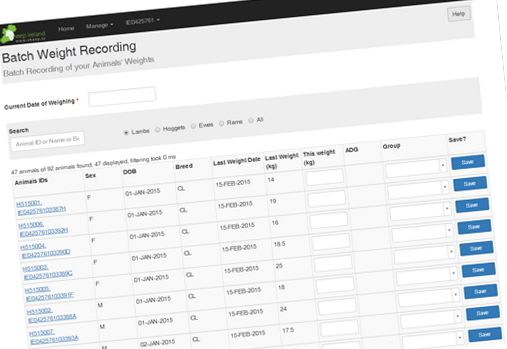Ovigen DNA collection update
Our campaign to collect DNA from all Irish performance recorded ewes and rams has begun. A number of flocks have been visited this week and all breeders will be contacted in the near future. As we collecting quite an amount of data from each flock, the process is labour intensive but the data being collected will be invaluable.
There are a number of different objectives within the overall Ovigen project, one of which will be the mapping of the relationship between the breeds in use across the Irish industry. In January we set out to make contact with the representatives of all our various sheep breeds to help us collect DNA samples for this breed mapping project. Our aim was to collect to 40 DNA samples from within each breed – taking care to avoid directly related sheep. The response from all breeds was excellent with many going to great lengths to provide these samples and the breeders involved in this should be commended for their dedication to their breed. The samples are now assembled and have been sent to the lab (Weatherbys) for DNA extraction.
Breeds that collected DNA for this project:
- Belclare
- Beltex
- Blackface Mountain – Kerry, Mayo-Connemara, Waterford
- Bluefaced Leicester
- Charollais
- Cheviot
- Lleyn
- Rouge
- Suffolk
- Texel
- Vendeen
- Zwartble
Steps involved in genotyping
The sampling method which we have employed is ear tissue sampling (similar to the BVD sampling). We used this due to it is the superior sample type compared to saliva swabs which are not as reliable. This tissue samples contain the DNA of the animal, but before the animals DNA can be genotyped, the DNA must be extracted from the ear tissue material. This is the next stage for our breed mapping samples. Once extracted the DNA is ready to go through the genotyping process.
Batch Weight Recording
A new screen has just been launched that now allows breeders to record multiple weights that were recorded on the same date in one go. This should greatly speed up the rate of data entry for our LambPlus breeders.
Below table 1 designed to aid breeders select the best time to weigh their LambPlus performance recording lambs. As part of the LambPlus programme breeders are asked to record at least 3 weights for their lambs after lambing, however breeders are free to record as many weights as they wish). Each of these weights will then work towards improving the flocks/ breeds accuracy percentage (Acc %) and therefore making the evaluations reflect the performance of animals on the ground more accurately.
All lambs DO NOT need to be weighed when they are exactly 40 days, 100 days or 150 days of age. If lambs are weighed between the parameters outlined below in table 1, the Sheep Ireland database will be able to predict the weight of the animal at age.
Table: 1
All LambPlus breeders will have received pocket Lambing Notebooks. On page 58 you will see there is a section to record lamb weights as they are recorded. All breeders can then record all these weights on-line and only breeders that selected paper recording can send their weights to Sheep Ireland to have the weights entered by Sheep Ireland staff


